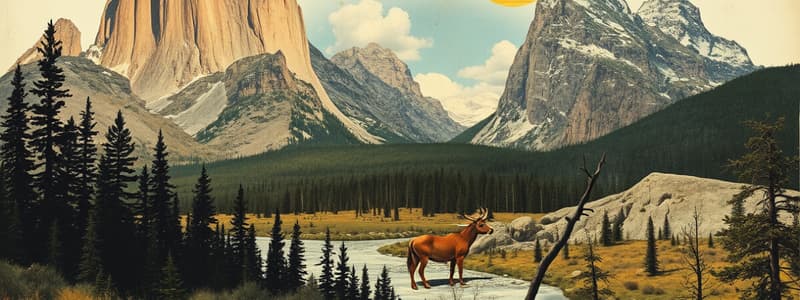Podcast
Questions and Answers
What is the primary purpose of establishing National Parks?
What is the primary purpose of establishing National Parks?
- To protect and conserve unique ecosystems and their biodiversity. (correct)
- To promote tourism and recreational activities.
- To develop infrastructure for education and research.
- To provide hunting grounds for wildlife.
What significant ecological change has occurred in Yellowstone National Park?
What significant ecological change has occurred in Yellowstone National Park?
- Increased tourism has improved biodiversity.
- The introduction of exotic species has revitalized the ecosystem.
- Human interventions have created new habitats for animals.
- The removal of wolves has led to a decrease in biodiversity. (correct)
Which of the following National Parks is known for its geological significance?
Which of the following National Parks is known for its geological significance?
- Grand Canyon, USA (correct)
- Uluru-Kata Tjuta, Australia
- Lake District, UK
- Banff, Canada
What has been a major threat to the natural beauty and ecological balance of National Parks?
What has been a major threat to the natural beauty and ecological balance of National Parks?
Where can you find a popular National Park for safari viewing?
Where can you find a popular National Park for safari viewing?
What was the primary consequence of the wolves' extinction in the ecosystem?
What was the primary consequence of the wolves' extinction in the ecosystem?
What specific effect did the reintroduction of wolves have on the grasslands?
What specific effect did the reintroduction of wolves have on the grasslands?
Which animal began to reappear in the ecosystem after the restoration of the wolves?
Which animal began to reappear in the ecosystem after the restoration of the wolves?
What was the effect on the river following the reintroduction of wolves?
What was the effect on the river following the reintroduction of wolves?
How did the absence of wolves in the ecosystem affect bird populations?
How did the absence of wolves in the ecosystem affect bird populations?
Flashcards are hidden until you start studying
Study Notes
National Parks Overview
- National Parks worldwide showcase areas of natural beauty, including Banff (Canada) and the Grand Canyon (USA).
- They serve as significant locations for scientific study and understanding of ecosystems.
- Designed to protect unique ecosystems and biodiversity, with strict limitations on development and controlled tourism.
Historical Context
- The concept of National Parks originated in the 1870s through American government initiatives.
- Grand Canyon features geological layers dating back approximately 1.7 billion years, providing insights into Earth's evolutionary history.
Popular National Parks
- UK’s Peak and Lake Districts are prominent among hikers and climbers.
- The Serengeti National Park in Africa is well-known for safari wildlife experiences.
- Uluru-Kata Tjuta National Park in Australia attracts visitors due to its cultural and natural significance.
Threats to National Parks
- Despite protective measures, human activities threaten the ecological balance in National Parks.
- There is a pressing need to enhance understanding of human-nature relationships for better conservation.
Case Study: Yellowstone National Park
- Over 50 years of research indicated a decline in biodiversity and degradation of the landscape.
- The extinction of wolves in the 1920s and 1930s due to hunting led to a significant food web imbalance.
Disastrous Food Web Imbalance
- Without wolves, prey populations (rabbits, deer) surged, leading to overgrazing and destruction of vegetation.
- Increased deer grazing prevented new vegetation from establishing, which further harmed plant and insect biodiversity.
Restoring Natural Balance
- In 1995, wolves were reintroduced to Yellowstone, restoring their role as apex predators.
- Their presence regulated prey populations, allowing grasslands and new vegetation to flourish.
Return to Rich Biodiversity
- The restoration of wolves led to the resurgence of diverse ecosystems, attracting more insect and bird species.
- The ecological recovery affected river courses and involved the return of other predators, ultimately revitalizing the park's biodiversity.
- Emphasizes the idea that nature thrives when humans minimize their interference, reflecting Sir David Attenborough's notion that “Nature requires our absence.”
Studying That Suits You
Use AI to generate personalized quizzes and flashcards to suit your learning preferences.




